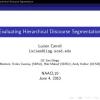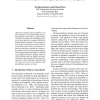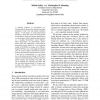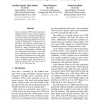NAACL
2010
13 years 9 months ago
2010
Taxonomies are an important resource for a variety of Natural Language Processing (NLP) applications. Despite this, the current stateof-the-art methods in taxonomy learning have d...
NAACL
2010
13 years 9 months ago
2010
NAACL
2010
13 years 9 months ago
2010
NAACL
2010
13 years 9 months ago
2010
Open-class semantic lexicon induction is of great interest for current knowledge harvesting algorithms. We propose a general framework that uses patterns in bootstrapping fashion ...
NAACL
2010
13 years 9 months ago
2010
A principal weakness of conventional (i.e., non-hierarchical) phrase-based statistical machine translation is that it can only exploit continuous phrases. In this paper, we extend...
NAACL
2010
13 years 9 months ago
2010
Out-of-vocabulary (OOV) words represent an important source of error in large vocabulary continuous speech recognition (LVCSR) systems. These words cause recognition failures, whi...
NAACL
2010
13 years 9 months ago
2010
This paper presents a direct word reordering model with novel syntax-based features for statistical machine translation. Reordering models address the problem of reordering source...
NAACL
2010
13 years 9 months ago
2010
Recently, relaxation approaches have been successfully used for MAP inference on NLP problems. In this work we show how to extend the relaxation approach to marginal inference use...
NAACL
2010
13 years 9 months ago
2010
NAACL
2010
13 years 9 months ago
2010
The class of Linear Inversion Transduction Grammars (LITGs) is introduced, and used to induce a word alignment over a parallel corpus. We show that alignment via Stochastic Bracke...




